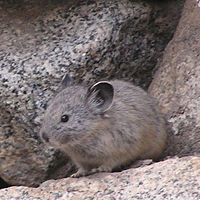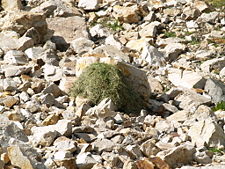Pika
| Pika[1]
| ||||||||||||
|---|---|---|---|---|---|---|---|---|---|---|---|---|
 American pika, (Ochotona princeps), in Sequoia National Park
| ||||||||||||
| Scientific classification | ||||||||||||
| ||||||||||||
| Ochotona minor Link, 1795 (= Lepus dauuricus Pallas, 1776) | ||||||||||||
|
See text |
Pika is the common name for small mammals comprising the family Ochotonidae of the rabbit order Lagomorpha, characterized by relatively large round ears, the lack of a visible tail, similar length of the forelimbs and hindlimbs, and smaller size than the related rabbit. Pikas are found in the mountains and steppe of central Asia and the mountains of eastern Europe and western North America. There is one extant genus, Ochotonoa, with about thirty species. Other common names for members of this family are mouse hare, rock rabbit, and coneys, as well as whistling hare due to its high-pitched alarm call when diving into its burrow.
Overview and description
The rabbit order, Lagomorpha, consists of two extant families, the pikas in Ochotonidae and the rabbits and hares in Leporidae. Based on molecular evidence, it is believed that these two families separated about 37 million years ago, in the early Oligocene.
Pikas are small hamster-like animals, with short limbs, rounded ears, and short tails.
The name pika (archaically spelled pica) is used for any member of the Ochotonidae, a family within the order of lagomorphs, which also includes the Leporidae (rabbits and hares). One genus, Ochotona, is recognised within the family, and it includes 30 species. Pikas are also called rock rabbits or coneys. It is also known as the "whistling hare" due to its high-pitched alarm call when diving into its burrow. The pika may look like a hamster, but is actually a cousin of the rabbit.
They are about 18-20 cm in body length, with a tail less than 2 cm long, and weigh between 75 and 290 grams, depending on species. Like rabbits, after eating they initially produce soft green feces, which they eat again to extract further nutrition, before producing the final, solid, fecal pellets.
These animals are herbivores, and feed on a wide variety of plant matter. Because of their native habitat, they primarily eat grasses, sedges, shrub twigs, moss, and lichen. As with other lagomorphs, pikas have gnawing incisors and no canines, although they have fewer premolars than rabbits, giving them a dental formula of:
| 2.0.3.2 |
| 1.0.2.3 |
Rock-dwelling pikas have small litters of less than five young, while the burrowing species tend to give birth to more young, and to breed more frequently, possibly due to a greater availability of resources in their native habitats. The young are born after a gestation period of between 25 and 30 days[3].
The name "pika" appears to be derived from the Tungus "piika", or perhaps from the Russian "pikat", to squeak. In the United States the pronunciation of the name is usually altered[4] from /pika/(peeka) to /'paɪ·ka/, probably due to the spelling.
Habitat
Pikas are native to cold climates, mostly in Asia, North America and parts of eastern Europe. Most species live on rocky mountain sides, where there are numerous crevices to shelter in, although some also construct crude burrows. A few burrowing species are instead native to open steppe land. In the mountains of Eurasia, pikas often share their burrows with snowfinches, which build their nests there[3].
In an article in the Journal of Biogeography, archeologist Donald Grayson warned that human activity and global climate change appeared to be pushing the American pika population to ever-higher elevations and thus possibly toward extinction[5]. Grayson studied pika habitation over the past 40,000 years in the region between the Sierra Nevada (U.S.) and Rocky Mountains. An earlier Journal of Mammalogy article reached a similar conclusion.
Activity
Pikas are diurnal or crepuscular, with higher altitude species generally being more active during the daytime. They show their peak activity before the winter season. Pikas do not hibernate, so they rely on collected hay for warm bedding and food. Pikas gather fresh grasses and lay them in stacks to dry. Once the grasses dry out, the pikas take this hay back to the burrows for storage. It is not uncommon for pikas to steal hay from others; the resulting disputes are usually exploited by neighboring predators like ferrets and large birds.
Eurasian pikas commonly live in family groups and share duties of gathering food and keeping watch. At least some species are territorial. North American pikas (O. princeps and O. collaris) are asocial, leading solitary lives outside the breeding season.
Species
- ORDER LAGOMORPHA[1]
- Family Ochotonidae: pikas
- Genus Ochotona
- Subgenus Pika: northern pikas
- Alpine Pika/Altai Pika, Ochotona alpina
- Collared Pika, Ochotona collaris
- Hoffmann's Pika, Ochotona hoffmanni
- Northern Pika/Siberian Pika, Ochotona hyperborea
- Pallas's Pika, Ochotona pallasi
- Subspecies
- Helan Shan Pika, Ochotona pallasi helanshanensis
- Subspecies
- American Pika, Ochotona princeps
- Turuchan Pika, Ochotona turuchanensis
- Subgenus Ochotona: shrub-steppe pikas
- Gansu Pika/Gray Pika, Ochotona cansus
- Plateau Pika/Black-lipped Pika, Ochotona curzoniae
- Daurian Pika, Ochotona dauurica
- Tsing-ling Pika, Ochotona huangensis
- Nubra Pika, Ochotona nubrica
- Steppe Pika, Ochotona pusilla
- Afghan Pika, Ochotona rufescens
- Moupin Pika, Ochotona thibetana
- Thomas's Pika, Ochotona thomasi
- Subgenus Conothoa: mountain pikas
- Chinese Red Pika, Ochotona erythrotis
- Forrest's Pika, Ochotona forresti
- Gaoligong Pika, Ochotona gaoligongensis
- Glover's Pika, Ochotona gloveri
- Himalayan Pika, Ochotona himalayana
- Ili Pika, Ochotona iliensis
- Kozlov's Pika, Ochotona koslowi
- Ladak Pika, Ochotona ladacensis
- Large-eared Pika, Ochotona macrotis
- Muli Pika, Ochotona muliensis
- Black Pika, Ochotona nigritia
- Royle's Pika, Ochotona roylei
- Turkestan Red Pika, Ochotona rutila
- Subgenus Pika: northern pikas
- Genus Ochotona
- Family Ochotonidae: pikas
Notes
- ↑ 1.0 1.1 R. S. Hoffmann, and A. T. Smith, "Ochotonidae," pages 185-193 in D. E. Wilson, and D. M. Reeder, eds., Mammal Species of the World, 3rd edition. (Johns Hopkins University Press, 2005) ISBN 0801882214.
- ↑ R. J. G., Savage, and M. R. Long, Mammal Evolution: An Illustrated Guide (New York: Facts on File, 1986). ISBN 081601194X.
- ↑ 3.0 3.1 Kawamichi, Takeo (1984). in Macdonald, D.: The Encyclopedia of Mammals. New York: Facts on File, 726-727. ISBN 0-87196-871-1.
- ↑ Google Books: Dictionary of American Regional English, Published by Harvard University Press, 1985, Page 145, http://books.google.com/books?id=i33BWgxbvXgC&pg=PA145&lpg=PA145&dq=pronounce+pika&source=web&ots=QvpQ80MvJ_&sig=omBHaKm4mAeD_FEE4I42yf95i2M&hl=en&sa=X&oi=book_result&resnum=7&ct=result#PPA145,M1
- ↑ Grayson, Donald K. (2005). A brief history of Great Basin pikas. Journal of Biogeography 32 (12): 2103-2111.
ReferencesISBN links support NWE through referral fees
R. S. Hoffmann, and A. T. Smith, "Ochotonidae," pages 185-193 in D. E. Wilson, and D. M. Reeder, eds., Mammal Species of the World, 3rd edition. (Johns Hopkins University Press, 2005) ISBN 0801882214.
R. J. G., Savage, and M. R. Long, Mammal Evolution: An Illustrated Guide (New York: Facts on File, 1986). ISBN 081601194X.
- Smith, A. T. 2004. Pikas (Ochotonidae). Pages 491-503 in B. Grzimek et al., Grzimek's Animal Life Encyclopedia. Detroit, MI: Thomson/Gale. ISBN 0787657921.
External links
- The Trek of the Pika "A story complete with sounds of pika calls" 2002-10-30
- [1] "A radio feature on how Pikas in the Rockies are coping with climate change. " 2007-07-31
- This article incorporates text from the Encyclopædia Britannica Eleventh Edition, a publication now in the public domain.
Credits
New World Encyclopedia writers and editors rewrote and completed the Wikipedia article in accordance with New World Encyclopedia standards. This article abides by terms of the Creative Commons CC-by-sa 3.0 License (CC-by-sa), which may be used and disseminated with proper attribution. Credit is due under the terms of this license that can reference both the New World Encyclopedia contributors and the selfless volunteer contributors of the Wikimedia Foundation. To cite this article click here for a list of acceptable citing formats.The history of earlier contributions by wikipedians is accessible to researchers here:
The history of this article since it was imported to New World Encyclopedia:
Note: Some restrictions may apply to use of individual images which are separately licensed.
